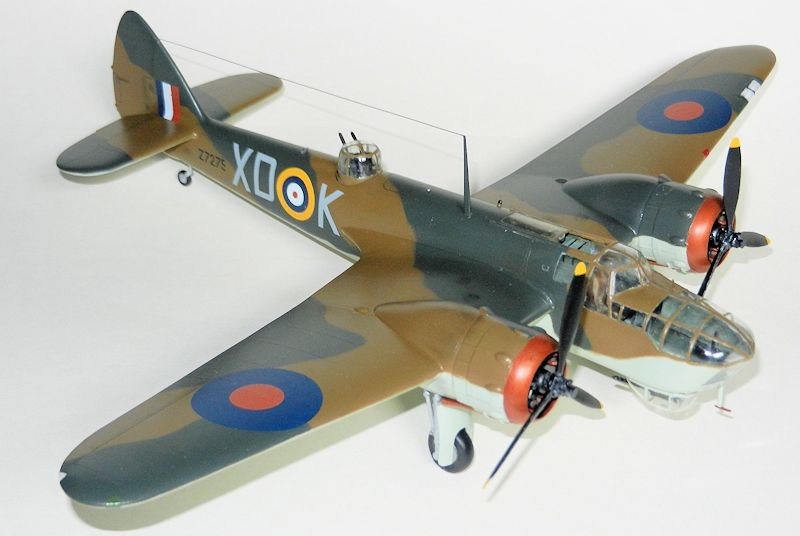
Classic Airframes 1/48 Blenheim IV
| KIT #: | 436 |
| PRICE: | $55.00 before the company went belly up |
| DECALS: | Two options |
| REVIEWER: | Pablo Calcaterra |
| NOTES: |
My ultimate tribute to Sqn Ldr Richard
Lindsell DFC RCAF |

| HISTORY |
Richard Campbell Lindsell was born in Buenos Aires, Argentina in 1916. He
completed his studies in England (Stowe College) and then returned to Argentina
where he started to work in Alpargatas, a very famous factory of fabrics.
In
September 1940 Richard traveled to Canada in the transport ship S.S. Uruguay.
Among the passengers other volunteers traveled to join the fight against the
Axis we can find Frankie Bell who flew with Lindsell in 139 Sqn in 1941 and
after flying support missions for the Chindits had a career at the RCAF after
the war, Gerry Pryor who died in a Blenheim in Malta, Dick Hughes who died in
1942 over Germany in a Halifax, Bernardo de Larminat who flew Hurricanes in 1942
in North Africa.
In
December they all joined the RCAF and Richard was trained in Mount Hope, Ontario
(EFTS 10) close to where I live, then moving to Brantford, Nova Scotia and
finally when training was over, he was sent to England by ship in May 1941.
Richard was transferred to OTU 13 were he trained to fly Blenheims. On August 27th,
1941 Richard and his crew (Pilot Officer Sydney Wells as navigator and Sgt.
Peter Ganthony as wireless operator and gunner) were posted to 139 Sqn based in
Manston. Other Argentineans were posted to this squadron on this same date:
George Hughes, and Frankie Bell. These were the times of the heroic Group 2
missions. It was at the end of a very active month for 139 Sqn with almost daily
bombing missions being flown over France. When the spare set of legs for Douglas
Bader was dropped on August 1941, 19th Lindsell had NOT joined the
Squadron yet…and 139 Sqn was not the Blenheim Squadron that took part in
Operation Leg! (Therefore it is clear
that he did not take part in this
mission as stated elsewhere).
After some training missions during August the squadron flew to Tangmere on
September 10th 1941 as a forward base. This was to be Richard’s first
operation. It was shipping bait in the
Le Havre area that was cancelled due to bad weather. Their plane was Z7275 “K”
which had been recently allocated to him.
More low level bombing practice took place in the following days. Flying “X”
Z6249 (Z7275 was in maintenance) a new mission started on September 14th.
After flying some miles away from the English coast at low height the shipping
bait to Den Helder was aborted due to the no show of part of the fighter cover.
Finally on the 18th their first taste of fight: a Circus operation
(with proper fighter cover) to the power station at Rouen (France). Again Z7275
was down so Lindsell flew in Z7300. It was afternoon mission in
 full
squadron strength led by Wing Commander Halliday DFC. They found inaccurate flak
and the bombing was found to be satisfactory (Z7300 was lost in October during
the same antishipping raid as 6249 with the loss of the entire crews…read below)
full
squadron strength led by Wing Commander Halliday DFC. They found inaccurate flak
and the bombing was found to be satisfactory (Z7300 was lost in October during
the same antishipping raid as 6249 with the loss of the entire crews…read below)
On
the 20th 6 machines of 139 Sqn took part in a shipping sweep to
Zaandvort. All planes returned without incident (Lindsell finally in his first
Op with Z7275) although they saw a convoy but did not engage it.
More training followed during the rest of the month and early October including
some cooperation ones with the Army.
The
next raid by 139 Sqn took place on October 11th when the Argentines
Frankie Bell and Ken Hughes along with 10 more Blenheims led by Sqn Ldr Webster
DFC flew their own planes in another uneventful Circus.
More Circus Operations took place during the month including the one on the 13th
when Frankie Bell’s Blenheim was hit by flak but managed to return to base.
Sqn
Ldr. Stubbs DFC in Z6249 and two other Blenheims (including Z7300 flown by Sgt
Gill) out of 6 that took part on a mission on the 15th failed to
return.
During these days Lindsell was practicing ultra-low level bombing in Z7275.
On
October 24th P/O Bigges DFC led 6 machines including Lindsell on an
anti shipping mission in the Ymuiden area. Though no ships were sighted they
were chased by enemy fighters that did not manage to attack them.
On
the 26th the mission was repeated but this time Lindsell was in the
lead of 4 planes. No shipping or enemy fighters were sighted.
Lindsell and 5 more pilots (including Ken Hughes) were assigned to Operation
Pantaloon: ferrying planes to Malta thru Gibraltar. Heavy training to manage
fuel consumption for the long haul took place in the following days. Their
Blenheims were tropicalized versions. On November 4th 1941 they flew
in “R” Z3944 from Portreath to Gibraltar via Coruna (Spain), Lisbon, and Cape
St. Vincent. On the 5th they did more fuel consumption tests and on
the 6th they did some calibration for communications with HMS Ark
Royal.
The
following day they took off for Malta. After contacting HMS Ark Royal and Argus
they led 5 long range Hurricanes to the island following a route that took them
close to Bizerte, Cape Bon, south of Pantellaria. This was called Operation
Perpetual and delivered 34 much needed Hurricanes to Malta. Returning from the
ferry mission HMS Ark Royal was torpedoed and sunk on November 13th.
From Malta Lindsell, Wells and Ganthony flew on to Mersa Matruh in Blenheim 7359
on November 20th. During this flight and in company of Ken Hughes in
O for Orange they were approached by 11 enemy bombers thought to be Ju88s who
got as close as 1,500 yards before changing direction and leaving them alone!
After refuelling in Mersa they continued along the coast to an airfield south of
Cairo where their Blenheims were delivered to the Mediterranean Command.
On
December 18th they started to return to the UK as passengers in a
Sunderland via Malta and Gibraltar arriving in Plymouth on the 20th
(Ken Hughes and crew had returned on the 14th)
With 110 (Hyderabad) Sqn:
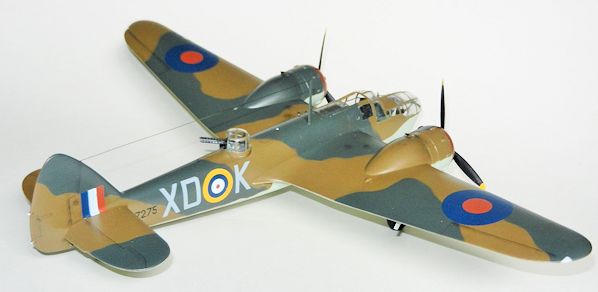
On
January 9th 1942 Lindsell, Wells and Ganthony joined this squadron
and spent the entire month practicing night flying for intruder missions over
enemy territory.
On
February 8th they flew their first mission to an enemy aerodrome (Soesterberg
near Utrecht, Holland) but it was called off due to bad weather.
The
famous Channel Dash took place on February 12th. In all-out effort by
the RAF 110 Sqn contributed 13 planes during the early afternoon hours. Out of
these one was lost and only one managed to get close to the ships, overflew them
but was not able to bomb due to low clouds (according to 110 Sqn AIR27). This
seems to be Lindsell as he relates in his log book that they arrived over the
area and in 10/10 clouds they located 4 destroyers with other small ships. They
circled them, did a bomb run but did not release the bombs while receiving very
accurate light and heavy flak in return. Climbing back into cloud they popped
down again and found the same formation after what they safely returned to base.
110 Sqn followed up with another sortie with 3 planes at 5 pm. Lindsell was one
of these and this time the foul weather prevented them from finding anything.
For
the remainder of the month 110 Sqn started to get ready to be transferred to
India. According to official RAF records he had accumulated with No.2 Group,
United Kingdom from September 1941 to February 1942:
Circus operations (France, occupied territory) - 3 hours
Shipping sweeps (Dutch coast, etc.) - 12 hours 25 minutes
Night intruder sorties to Holland - 2 hours 50 minutes
Scharnhorst and Gneisenau ops, 12 Feb 42 - 3 hours 15 minutes
By
early March Richard Lindsell had been promoted to Squadron Leader and put in
charge of A Flight. On the 18th, along with his loyal Sidney Wells
and Peter Ganthony they took off for Gibraltar in Blenheim Z7293. After a couple
of days of calibrating their equipment with HMS Eagle they left for Malta on the
21st, found Force “H”, picked the Spitfires they were to shepherd led
by Sqn Ldr. Jumbo Gracie and including future aces like Dusty Miller and Slim
Yarra. There was supposed to be a second Blenheim in the mission but it never
arrived so instead of delivering 16 Spits only 9 made it to the beleaguered
island. It was a 700 mile trip that was made at very low altitude. There were
areas with rain and fog. An unsuccessful climb above the clouds was made and
thus they continued flying at low level. Close to Pantellaria a squadron of CR42
was seen but each party continued their own way. After almost 4 hours flying
they arrived to Malta.
On
March 22nd they flew on to El Fayoum and then continued to Wadi
Natrun where they picked 5 long range Hurricanes and 2 more Blenheims, Aquir (1
Blenheim and 2 Hurricanes left behind), Habbaniyah where they arrived on March
31st along with the other Blenheim and 3 Hurricanes. From there they
flew to Bahrein and after several refuelling stops they arrived in Karachi
(India) on April 1st 1942. After pickin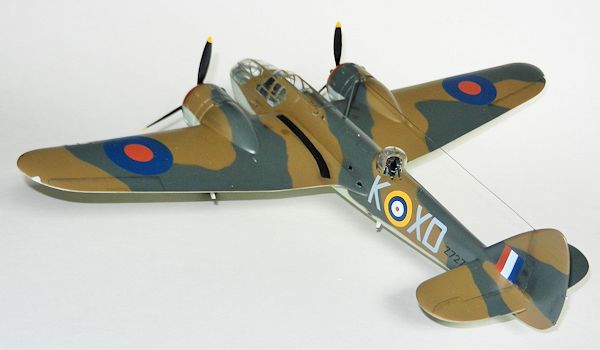 g
up 2 more Hurricanes at Jodhpur (for a total again of 5) they finally arrived in
Delhi on April 8th thus finishing this 20 day trip.
g
up 2 more Hurricanes at Jodhpur (for a total again of 5) they finally arrived in
Delhi on April 8th thus finishing this 20 day trip.
After many weeks to rest and recover flying activities resumed in November when
training to convert to Vultee Vengeance begun. It is said that because he did
not want to part ways from his crew he became a Flight Lieutenant at the end of
the year. With their new planes he flew some operations searching for Japanese
submarines.
On
March 30th, 1943 he was informed that he was again a Squadron Leader,
and that he was being transferred to 60 Sqn, flying Blenheims as Commanding
Officer. He took Sidney and Peter with him as crew.
This squadron still had Blenheims and on April 2nd 1943 Richard led
the squadron in his first mission as their commander, bombing Japanese positions
at Pinshe. Thinganet, Sowebo, Atwin, Paletna, Kappagyaung and other targets
followed as the Army was requesting support. Conditions in the base were very
basic but still managed to carry out many successful missions that go beyond the
scope of this article.
With deep regret and disappointment the crews found that the Squadron was going
to convert to Hurricanes. Therefore navigators and gunners were not needed any
more and were posted elsewhere. July saw Sqn Ldr Lindsell’s 60 Sqn starting the
conversion to Hurricanes.
Lindsell got his lucky charm painted on the nose of his Hurricane called
Suertudo. His mother got him a fabric figure of the Argentine cartoon Patoruzu
to be his lucky charm. That very same figure is the one painted on the plane
(The fabric Patoruzu is still with Richard’s family).
For more information about his actions with 60 Sqn please check here (please note that mistakenly I called him Ricardo in this article though he was never referred to by the Spanish version of his name) but let me tell you that I have found much more information about the Hurricane times and that I wish I had had that info when I wrote the article.
In
all and a summary of his actions with 60 Sqn we can tell that Richard flew:
Arakan Front (Blenheim IVs), March to May 1943
Close support bombing operations - 16 hours 40 minutes
Long-range strategic bombing (airfields, etc.) - 9 hours 35 minutes
Offensive bomber and road reconnaissance ops. - 3 hours 35 minutes
India (Hurricane IIc aircraft), November 1943 to May 1944
Scrambles and searches - 7 hours 15 minutes
Bomber and transport escorts - 40 hours 15 minutes
Day long-range rhubarbs - 6 hours 55 minutes
Night long-range rhubarbs - 3 hours 35 minutes
A.S.C. Strafing (Arakan) - 3 hours 5 minutes
A.S.C. Hurri-bombing and strafing, Imphal and Chindwin - 69 hours 40 minutes.
 In June
1944 Richard left his 60 Sqn and after a trip by ship he arrived in Liverpool
very tired. In London he met his wife Patsy after two and a half years. She was
also a member of the Armed Forces and because of her fluent German was tasked
with listening to the radio conversations of the German aircrew in their
missions over England.
In June
1944 Richard left his 60 Sqn and after a trip by ship he arrived in Liverpool
very tired. In London he met his wife Patsy after two and a half years. She was
also a member of the Armed Forces and because of her fluent German was tasked
with listening to the radio conversations of the German aircrew in their
missions over England.
His
leaders wrote of him:
”Squadron Leader Lindsell has been
responsible for the training and extreme efficiency of his squadron on
operations after re-equipping from Blenheim aircraft to Hurricane bombers.
Through his energy and leadership his squadron carried out 728 sorties from the
1st April to 2nd May 1944, during which time many congratulatory signals were
received from the forward army units, on the accuracy of their bombing, who were
on occasions only 100 feet away
from the target. This officer has shown exceptional keenness for operations and
his powers of command, leadership and devotion to duty are outstanding”
Commanding Officer of No.189 Wing (W/C P.K. Devitt) 5 June 1944
”The manner in which Squadron Leader Lindsell converted his squadron to a
remarkably reliable and accurate Hurri-bomber squadron in a very short space of
time on joining this Group was worthy of the highest recognition. His personal
keenness and powers of leadership have made the squadron into a really good one,
both from the point of view of operational results and aircraft serviceability.
He has personally led the squadron on many extremely dangerous and successful
sorties. Strongly recommended for the award of the Distinguished Flying Cross.”
Air Commodore commanding No.221 Group (21 June
1944)
In
September 1944 he was given the DFC. Text read: “Squadron Leader Lindsell has
led his squadron on many hazardous and successful sorties. He has also been
responsible for the training and efficiency of his squadron on operations after
conversion from Blenheim aircraft to Hurricane bombers. In one month in 1944 his
squadron completed 728 sorties and as the result of the accuracy of their
bombing received many congratulatory signals from the forward Army units.
Throughout this officer has displayed outstanding leadership and devotion to
duty”
In
January 1945 he was sent to Canada. He was transferred to No.1 Air Command in
February 1945 and released on May 2nd 1945. On May 26th
1945 he retired from the RCAF.
He
tried to return to Argentina hitchhiking by plane! After several hops thru the
US, Mexico and Central America he contracted
hepatitis. He was so sick in a hotel in the Amazon area that he passed out.
Luckily he was found in his room and thanks to his name tag around his
neck he was identified, sent urgently to a hospital in Canada where he recovered
and finally again by plane this time he made it to Argentina in later in 1945.
In September he returned to his old work at Alpargatas. He worked there for
almost 2 years and then returned to the UK where he worked for 9 years. Then he
went to live in 1955 to Venezuela, in 1967 back to the UK, and then Spain.
Richard Campbell Lindsell died in England in October 1998. Out of his group of
16 volunteers, only 3 survived the war (among them Malcolm Benitz who was
brother in law of “Pancho” le Bas, another Argentine who flew in Malta and had a
long career in the RAF after the war)
Richard never regained contact with his former
crew after they parted ways. We now know that this is what happened to them:
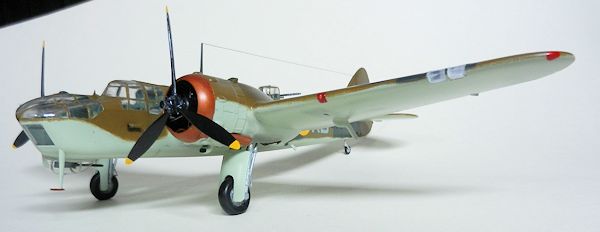
We have found no details of the career of Sgt. Peter Ganthony after 60 Sqn. but Matt Poole has found that a Peter C. Ganthony died age 41 in 1959 in the UK. I have just found that this person married in 1948. There are two Peter Ganthony born between 1900 and 1925. But this Peter’s middle name starts with a “C” like Sgt. Ganthony so most likely Lindsell’s Wop/Ag passed away in 1959.
| THE KIT |
A Preview
of the kit by Scott can be found
here
| CONSTRUCTION |
The
good thing about this kit is that there are so many sub assemblies that you can
work on several things at the same time. There is also a lot of resin to be
cleaned from the parts.
So
the sub assemblies I started to work on were the following:
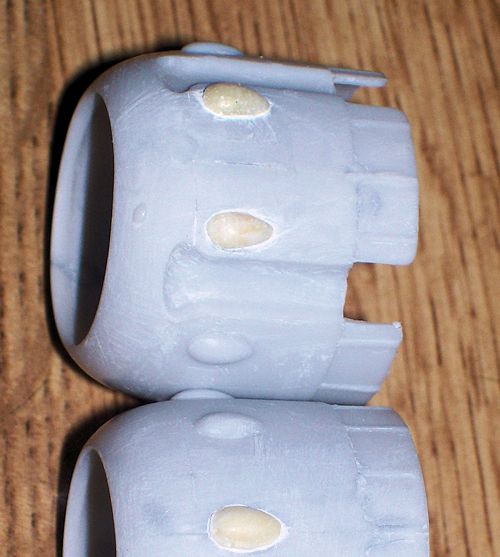 Engine
cowlings: glued together. I managed to lose a couple of the bumps for the
cylinder heads so I had to copy them in resin…the gap between the resin and the
plastic was covered with acrylic base paste (white)
Engine
cowlings: glued together. I managed to lose a couple of the bumps for the
cylinder heads so I had to copy them in resin…the gap between the resin and the
plastic was covered with acrylic base paste (white)
Instrument panel: painted in black and with details highlighted using walk
around pictures. Drops of Future represent the glass on the gauges. I used
stills from the documentary “Blenheim at war and at peace” to use the correct
colours for the dials and different knobs and controls. The fire button on the
control column was painted using a mix of yellow and silver.
Rear bulkhead and crew seats: The fit of this part inside of the fuselage halves
requires a lot of sanding, surgery and dry fitting. For starters, the molded
support for the border of attack of the wings to the fuselage needs to be
removed and a considerable amount of resin has to be sanded for the halves to
properly close without misplacing the bulkhead. With this accomplished the
structure was painted Interior Green with leather in Dark Brown and seat belts
(PE from the spares box) in beige with silver details.
Wheel wells: as this is the early version of the kit I was forced to sand
fantastic amounts of resin AND the interior side of both wing halves to make the
parts fit. I believe it took me
 around
4 to 5 hours of sanding, dry fitting and more sanding to get each well to fit
properly…Once this was accomplished the two wheel wells were carefully aligned
and glued using two part epoxy.
around
4 to 5 hours of sanding, dry fitting and more sanding to get each well to fit
properly…Once this was accomplished the two wheel wells were carefully aligned
and glued using two part epoxy.
Gun
turret: The machine gun located in the turret is very simple and spartan. I
decided to scratchbuild the missing parts. I went to the Museum in Hamilton, ON
where they are restoring a Bolingbroke to flying condition (first flight
scheduled for July 2015) and they already have the turret ready. I took pictures
from every single angle and with these pictures I scratchbuilt all the missing
parts: boxes for the storage of the ammo belts, cushioned pads on top of these
boxes, fabric made collectors for spent cartridges, runners for the ammo belts,
the support of the chin of the gunner behind the shield for his face, gunsight,
different handles and levers for the guns…The entire structure was painted
Interior Green with the “leather” parts in dark brown and handles in black.
Metallic structures like guns, runners, gunsight were drybrushed in silver.
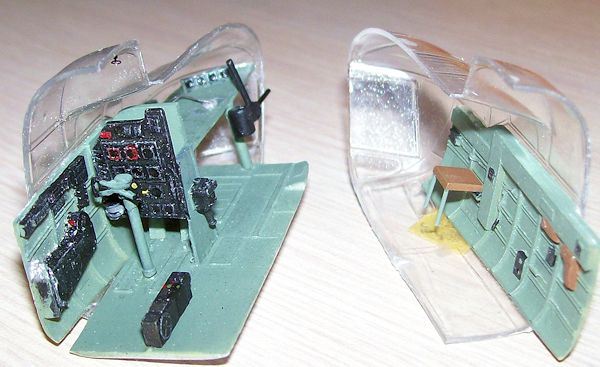 Cockpit:
To avoid having a vertical seam running across the triangular central section of
the windshield this one was removed and replaced with a single piece
scratchbuilt later on. As I was planning on building the plane with the crew
access latch open I then cut out that clear part from the side windows thus
ending up with 3 parts. Now that the main floor with the instrument panel and
consoles was ready it was time to attach the sidewalls to the 2 clear nose
halves. These 4 parts are too thick and required (especially on the top part)
lots of sanding. With two part epoxy the sides were glued to the clear parts.
Everything was painted according to colour pictures. The floor with the
instrument panel was slid under the left fuselage side. Scratchbuilt details
were added to the area: 2 legs for the navigator seat, a support for the
navigator table, a bombsight (with a decal for the dials) was attached to the
support for the table, the ruler/support for the maps on the navigator’s table
(made with wire, clear flat plastic and a round plastic for support). A folded
up PE gunsight was added to the internal frame in front of the pilot seat.
Cockpit:
To avoid having a vertical seam running across the triangular central section of
the windshield this one was removed and replaced with a single piece
scratchbuilt later on. As I was planning on building the plane with the crew
access latch open I then cut out that clear part from the side windows thus
ending up with 3 parts. Now that the main floor with the instrument panel and
consoles was ready it was time to attach the sidewalls to the 2 clear nose
halves. These 4 parts are too thick and required (especially on the top part)
lots of sanding. With two part epoxy the sides were glued to the clear parts.
Everything was painted according to colour pictures. The floor with the
instrument panel was slid under the left fuselage side. Scratchbuilt details
were added to the area: 2 legs for the navigator seat, a support for the
navigator table, a bombsight (with a decal for the dials) was attached to the
support for the table, the ruler/support for the maps on the navigator’s table
(made with wire, clear flat plastic and a round plastic for support). A folded
up PE gunsight was added to the internal frame in front of the pilot seat.
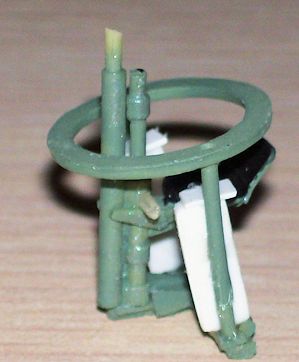 The
turret is a problem in itself…the ring below it is too shallow and the opening
for the machine gun is correct for the VGO version but too narrow for the twin
303s. I proceeded to very carefully open up the area thru which the guns stick
out. I curved two strips of thin plasticard and glued them between the main
clear turret part and the clear ring and another one under the ring. This would
allow me to make the turret to sit at the proper height and would represent the
main frame of the ring. The Plexiglas almost rectangular windows on the ring
were masked along with the main panels on the turret.
The
turret is a problem in itself…the ring below it is too shallow and the opening
for the machine gun is correct for the VGO version but too narrow for the twin
303s. I proceeded to very carefully open up the area thru which the guns stick
out. I curved two strips of thin plasticard and glued them between the main
clear turret part and the clear ring and another one under the ring. This would
allow me to make the turret to sit at the proper height and would represent the
main frame of the ring. The Plexiglas almost rectangular windows on the ring
were masked along with the main panels on the turret.
(Beautiful) engines: were painted in black, the details highlighted with a
silver drybrush. Some sanding was required to make them fit inside the cowlings.
Piping for the collector rings is made in tiny “L” shaped resin. I had to trim
them slightly to make them fit and then painted them with Rust. With lots of
patience these were glued one by one using instant glue (gel type as it allows
making corrections). I managed to
knock some off and glued them back in place. The supports for the front of the
engine were made with cut pieces of stainless wire and glued using instant glue
too. With this ready I covered the engine with
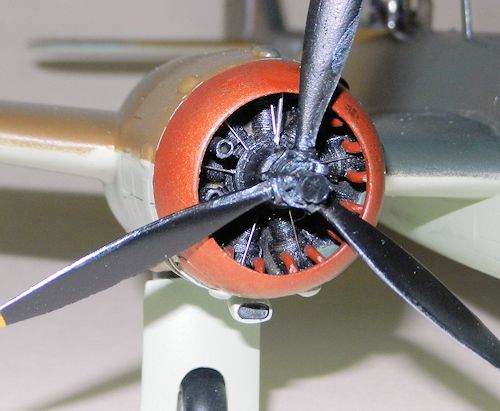 damped
tissue paper. The rounded edge air intakes for the engines (3 types are supplied
with the kit: round edge, rectangular and tropical) were added to the bottom
side of the cowlings.
damped
tissue paper. The rounded edge air intakes for the engines (3 types are supplied
with the kit: round edge, rectangular and tropical) were added to the bottom
side of the cowlings.
Planes of 139 Sqn carried both type of exhausts for the engines: original or
early type and the ones with flame dampers (which were, based on photographs,
the majority). The kit only has the original type. These 4 pieces I painted in
bronze and dry brushed with Rust colour. The opening was painted with black
paint. Then they were attached without fuss to their cowlings. There are two
supports for each exhaust that are vaguely marked in the kit. I scratch built
these and glued them on top of the exhausts. Then I masked the bronze parts to
get the area ready to be given the cammo colours.
Main structures:
a)
Fuselage:
Now
that the cockpit was ready (after several days of work as you can tell) the
halves were carefully glued together. More epoxy was added under the floor to
strengthen the union along with plasticard strips for support. Fit of the two
halves of clear plastic was not very good and I had to sand a lot of plastic and
use putty to correct some gaps/steps.
The
little windows behind the pilot are engraved in the grey plastic fuselage
halves. I decided to make them in clear plastic. For this I just cut out the
tiny rectangular area, replaced it with clear plastic from the spares box, used
putty to improve the union of the parts and them masked the clear part leaving
it ready for painting later on.
The
big chunk of resin with the seats was glued with 2 part epoxy to the fuselage
halves. The support for the turret was glued with some corrections to make it
fit properly (it is too wide). Then both halves of the fuselage were cemented.
Once the glue was dry there was lots of work to do to make the gap along the
spine and belly smooth (putty and sandpaper).
Part # 27 that covers the turret area is too wide and also lacks the wavy
surface located towards the rear of the plane. This “waviness” was added with
careful sanding and once it was ready the part was attached to the fuselage with
the excess of plastic on the sides being sanded until there was a nice and
smooth transition.
Finally (!) I was ready to attach the nose to the fuselage. I used epoxy for the
resin parts and plastic cement for the clear/gray plastic parts. There was a
significant gap at the bottom…so large that instead of using putty I build up
layers of two part epoxy that I successively sanded and built until it was small
enough to allow the use of putty. Panels had to be re-scribed on the bottom and
external sides of the fuselage. The task is pretty difficult because two part
epoxy is not a good friend of scribing tools and trends to either crack or break
loose…
Note that the side windows for the pilot should be of the blister type but the
kit only brings the flat (early) ones and I was unable to source blisters with
the correct dimensions.
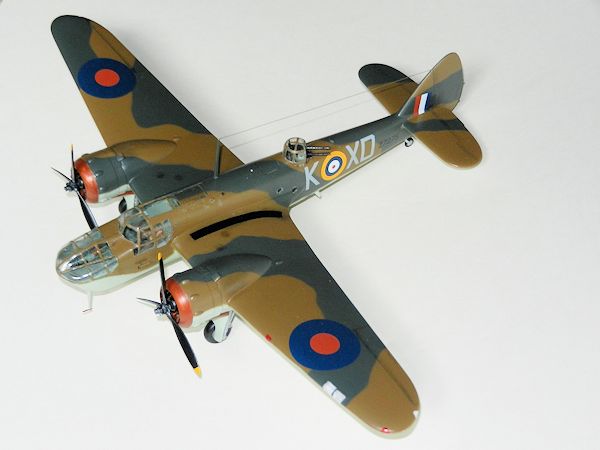 With this
completed I sanded out the runners for the cockpit access hatch as these are too
shallow. I cut strips of plasticard to make not only the runners but also the
front portion where the hatch latches. This one has curved edges. I hid some
little gaps using putty.
With this
completed I sanded out the runners for the cockpit access hatch as these are too
shallow. I cut strips of plasticard to make not only the runners but also the
front portion where the hatch latches. This one has curved edges. I hid some
little gaps using putty.
The
hatch itself was made from a piece of acetate cut to shape (the discarded
injected plastic one was too thick to make it sit over the fuselage in between
the runners) and the frames were also cut from acetate and glued using Instant
glue. The exposed clear area was masked.
The
machine gun for the navigator had to be scratchbuilt. Using a reference from
Internet that has drawings for every single kind of turrets used in planes flown
by the British during WWII I built with plasticard the support for the .303 gun
supplied by the kit. Then I painted it in black with some drybrushing in silver.
The blister was cut out and sanded carefully till a nice fit to the nose was
achieved. The panels were masked for painting later on.
b)
Wings:
With the resin wheel wells in place I glued the top half of the wings. Once this
was dry I cut out the landing lights as I was going to scratch build them with
clear plastic.
The spent cartridges chute for the wing
mounted gun was carved out. After sanding the border of attack and the engine
nacelles I had to re-scribe some panels. The wing root was not very even and I
sanded it vigorously to get a decent surface to be matched to the fuselage.
The
next challenge was to add the landing lights. I carefully cut out the plastic
leaving the frames in place. I looked for very thick clear spruces in the spares
box and found some that were ALMOST the correct thickness. They left a little
gap in the undersides. I attached this clear plastic using copious amounts of
glue that was used to fill up the gaps. The plastic was not eaten by the
corrosive glue so this was good news. I sanded the area until I achieved a
decent look and gave the clear parts a thick layer of Future.
Position lights (clear and colored) were also cut out from the plastic and made
with more clear spruce from the spares box. This required extra glue to cover
the gaps, putty for the gray plastic areas and Future to cover the clear areas
and make them shiny.
Putting everything together (subassemblies, wings and fuselage):
By
now probably 3 months had gone by since starting the project and the fuselage
and the wings were mated. Fit was not good at all and I struggled a lot to get
both wings sitting at the correct angle. With this accomplished I covered the
gaps with putty and after sanding the excess I had to re-scribe several panel
lines.
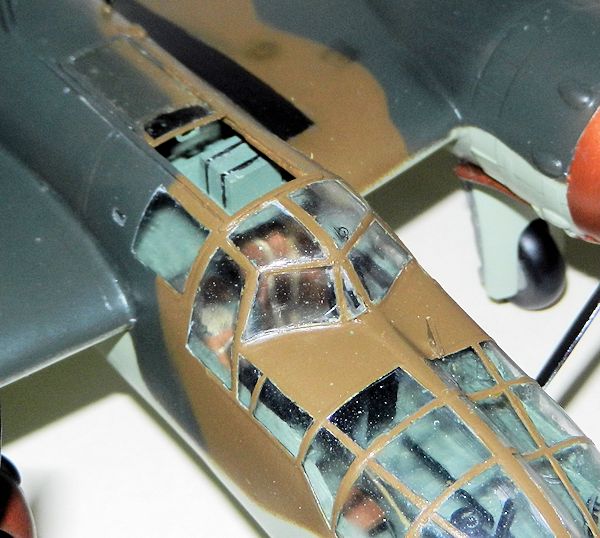 At last I
was able to glue the horizontal surfaces of the tail but not before having to
correct their root for them to sit with their border of attack perpendicular to
the fuselage (more putty)
At last I
was able to glue the horizontal surfaces of the tail but not before having to
correct their root for them to sit with their border of attack perpendicular to
the fuselage (more putty)
The
multiple windows were masked, the opening for access to the cockpit and the
turret area where covered with tape. The emergency fuel dumping pipes were glued
under the wings.
Now
I was able to give the entire coat a hand of Interior Green (Modelmaster 4850)
that would serve two purposes: give the color to the interior frames of turret
and nose and also check imperfections in all the unions of the main parts. The
colour chosen for the undersides in order to look for imperfections was actually
the cammo one: RAF Sky (Modelmaster 4840). I fixed some details here and there
with putty and sandpaper.
At
this point I glued the engines in place. By looking at the pictures of the
Blenheims during the times that Lindsell served with 139 Sqn I found that there
was a rectangular structure on the top left side of the cowlings. I took the
unused rectangular air intakes and cut and sanded them to represent these
(intakes or exhausts?). As I had already glued the cowlings I was forced to
carefully cut out the cooling grids in the area and then attach the modified air
intakes. I had to use some putty to improve the union.
I
scratchbuilt the chute for the flares (bottom left side underneath the turret).
The
final bits to add to the plane before cammo painting started where some little
structures along the fuselage. These were scratchbuilt using the spares box and
include an air exhaust (?) close to the runners for the hatch on the left side,
the support for the antenna, a triangular “protection” (?) for a little pointy
thing sticking out just behind the turret and a white light bulb ahead of the
turret.
| COLORS & MARKINGS |
Already having painted the undersides in Sky and the fragile landing gear in
Silver I masked these using worms of blue tack for the delimitation lines.
First applied RAF Dark Brown (Modelmaster 4846) to the entire top surface. Then
I made copies of the demarcation lines of a Mk1 Blenheim as seen in the book
Bombers of War World II (Metrobooks), cut them out, attached them using Tamiya
tape and more blue tack for the delimitation areas. Note that Z7275 had the
opposite cammo scheme so the paper masks were attached upside down and reversed
(right changed to left). Dark Green (Modelmaster 4849) completed the main colour
scheme.
Once the masks were removed and imperfections in the paint were checked out
painted the collector ring in bronze and dry brushed it with rust. I glued the
landing gear in place (note that this is a different order than the
instructions).
The anti-slipping band on the left wing was
painted with black after carefully masking the area around it.
Sanded black pastel was applied with a brush around access panels, lids, behind
the cowling flaps, moveable surfaces, etc. Several
layers of Future gave a smooth surface for the decals.
A silver pen was used to “chip” some
paint here and there.
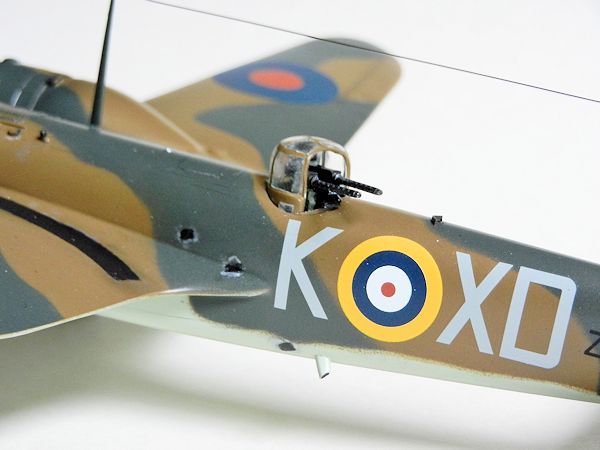 Squadron
codes came from Xtradecals, roundels from Classic Airframes, serial numbers from
Carpena. Finding out the correct letter assigned to this plane was a challenge.
This research took me a couple of weeks and almost eroded the patience of the
Lindsell family as I kept on asking for better quality scans of the pictures of
139 Sqn that they have. I knew I wanted to build Z7275 based on the fact that
most of the pictures they have are of 139 Sqn so it would be easier to properly
paint the plane. Also this was his plane assigned during his first tour. But the
individual letter was a big mystery. Looking as much as I could at all the
planes in those pictures I was unable to positively identify Z7275 by their
serial number. Going thru Lindsell’s log book then I realized that he had
changed the way he was recording his planes’ serial numbers. Initially he was
using the Squadron individual letter and then after a few records he changed to
the entire serial number. So, as an example, he first records K7275 and then he
starts to write Z7275. After double checking with the UK Serial Number website
and confirming that there never was a Blenheim K7275 and that the only Blenheim
with a 7275 serial was “Z” it became clear that “K” was the individual Squadron
assigned letter for this plane.
Squadron
codes came from Xtradecals, roundels from Classic Airframes, serial numbers from
Carpena. Finding out the correct letter assigned to this plane was a challenge.
This research took me a couple of weeks and almost eroded the patience of the
Lindsell family as I kept on asking for better quality scans of the pictures of
139 Sqn that they have. I knew I wanted to build Z7275 based on the fact that
most of the pictures they have are of 139 Sqn so it would be easier to properly
paint the plane. Also this was his plane assigned during his first tour. But the
individual letter was a big mystery. Looking as much as I could at all the
planes in those pictures I was unable to positively identify Z7275 by their
serial number. Going thru Lindsell’s log book then I realized that he had
changed the way he was recording his planes’ serial numbers. Initially he was
using the Squadron individual letter and then after a few records he changed to
the entire serial number. So, as an example, he first records K7275 and then he
starts to write Z7275. After double checking with the UK Serial Number website
and confirming that there never was a Blenheim K7275 and that the only Blenheim
with a 7275 serial was “Z” it became clear that “K” was the individual Squadron
assigned letter for this plane.
A
round tiny black decal was used to represent the air intake for the navigator on
the tip of the nose.
| FINAL CONSTRUCTION |
A
coat of semi-gloss clear coat was applied to the entire plane. All windows
received a hand of Future applied with a brush.
 Parts that
I glued at this point were antenna mast, tail wheel, landing gear doors,
propellers, hatch (with a scratch built handle for the pilot to close it), bead
part of the gunsight (glued on frame in front of pilot), antenna with stainless
steel wire, pitot tube, position lights with a mix of Future and red/green
paint, position light on the rudder with white paint.
Parts that
I glued at this point were antenna mast, tail wheel, landing gear doors,
propellers, hatch (with a scratch built handle for the pilot to close it), bead
part of the gunsight (glued on frame in front of pilot), antenna with stainless
steel wire, pitot tube, position lights with a mix of Future and red/green
paint, position light on the rudder with white paint.
The
turret was installed in place but I had to wriggle a lot because the collectors
for the spent cartridges kept on getting in the way and bumping against the
turret ring (looking back I have probably made these collectors 1 or 2 mm too
wide). Finally I had to concede a little bit and fit the guns slightly further
back (giving little room for the head of the gunner!) but the final look is
quite good and I am satisfied with the entire area.
With this the kit was completed.
| CONCLUSIONS |
Very good kit that with all the modifications and improvements took me 5 months
to finish.
This is my tribute to Sqn Ldr Lindsell and his crew (Sidney and Peter) and all
his friends and colleagues who left their homes (in many cases distant ones) to
fight against the Axis.
Postscript:
After sharing the pictures with the Lindsell family they commissioned me to
build one Blenheim for each one of them…So we bought 4 Airfix 1/72 kits in eBay,
Xtradecal decals and roundels (as most of the kits I bought were from the
1970/early 1980 productions and thus unusable) and I built them. The advantage
of the Airfix kit is that the blisters for the pilot are there, the exhausts for
night operations are there but there is no under nose blister for the navigator.
These 4 kits were built all at the same time (experiencing different challenges
as the age of the mouldings increased and poorer fit and more flash was found in
many parts) and a few weeks ago delivered to their new owners.
| REFERENCES |
The
Lindsell family
AIR 27
for 139 Sqn and 110 Sqn
Air
Force Association of Canada
Spitfires over Malta, Brian Cull with Frederick Galea
“Nacidos
con Honor”, Claudio Meunier, October 2007 – Thanks Claudio for putting me in
contact with the Lindsells!
UK
Serials Resource Center
September 2013.
If you would like your product reviewed fairly and fairly quickly, please contact the editor or see other details in the Note to Contributors.